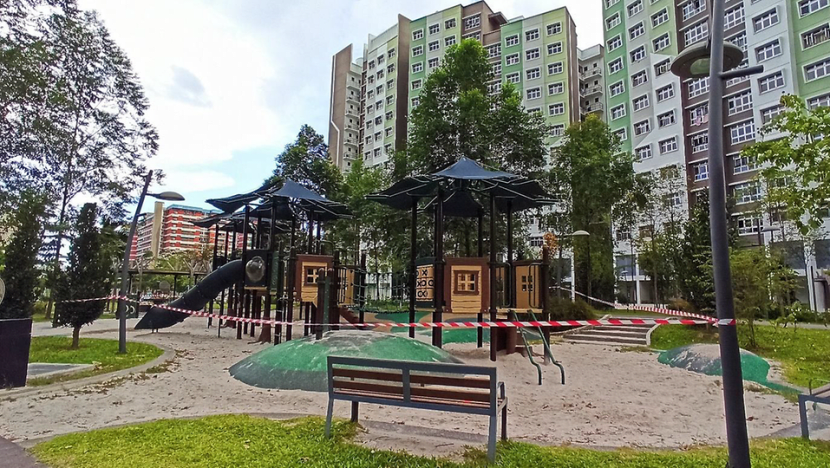commentary Commentary
Commentary: For your neighbours’ sake, turn the volume down this stay-home period
Neighbours are vital to the success of stay-home measures, says Kelvin Seah.

Housing and Development Board flats in Singapore. (File photo: Alif Amsyar)
SINGAPORE: Last week, shortly after Singapore implemented a slew of circuit breakers to stem the spread of COVID-19, I had my usual late afternoon jog around my neighbourhood.
As I did so, I felt a noticeable increase in noise levels coming from the blocks around me.
Now, don’t get me wrong. Most flats were reasonably quiet. However, as I made my way past the neighbourhood, I couldn’t help but notice the noise coming from a few households.
At one, a man was happily jamming away on his karaoke system at a level audible even from several blocks away. He was screeching away to Wang Leehom’s Forever Love.
He wasn’t the only one. Several blocks down, there were a couple of others on their karaoke systems. Loud music and TV sounds could also be heard from others.

With many people now staying at home, and some getting to enjoy a long break from work, unsurprisingly, many are making the most of their home entertainment systems.
LOTS OF NOISE AND LOUD MUSIC
As I continued exercising, I wondered how students engaged in home-based learning or workers who are currently telecommuting might be coping with all of this.
Surely, for home-based learning to be successful or telecommuting workers to remain productive, a conducive home environment is essential. This means having a quiet and peaceful environment to study and work in.
Loud music and other noise created by inconsiderate neighbours work against this end. Indeed, recent work by economist and behavioural scientist Joshua T Dean, from the University of Chicago’s Booth School of Business, shows that exposure to noise lowers worker productivity.
LISTEN: Disruption 101: How COVID-19 is revolutionising work
READ: Commentary: The time of introverts has come as firms ramp up work-from-home arrangements
Using a randomised experiment in Kenya where he randomly exposed participants to engine noise, Dean estimates that increasing noise levels by 10 dB(A) (comparable to raising noise levels from that produced by a dishwasher to that produced by a vacuum cleaner) decreases worker output by approximately 5 per cent.
Follow-up tests show that one mechanism through which noise affects worker performance is by impeding cognitive functions such as attention and working memory. Simply put, when people are exposed to noise, cognitive functioning decreases.
SOME NOISE CAN BE AVOIDED
We live in a densely populated environment here in Singapore, with many units nested in a single HDB or condominium block. As such, any sounds created by one household might potentially be heard by many others.
It is therefore essential for us to be cognisant of the fact that we might be disturbing, and hence imposing a cost on others, whenever we are noisy.
READ: Commentary: Home-based learning can be an opportunity to rethink parenting
LISTEN: Home-based learning: Good, bad, terrible ... but mostly good?
While activities such as loud music and karaoke singing might have been less costly to neighbours and society in the era before the circuit breaker, the cost has now risen with individuals required to work and study from home.
Of course, some forms of noise – such as the crying of a baby or the playing of children – are difficult to avoid, and most people would be sympathetic.
However, noise produced by loud music, karaoke sessions, playing of mahjong, and other entertainment systems, are louder, hardly essential and can be avoided.
SOME TIPS TO CONTROL NOISE LEVELS
For instance, instead of playing music loudly, individuals could don a headphone to enjoy their music at the desired volume.
They could also ensure that their windows are shut, and the volume of their entertainment systems kept to a minimum, if they really need that karaoke fix.

Or they could simply sing along without a microphone.
They could also limit the time devoted to such noise-creating activities and ensure that they do not engage in them at times of the day when they are likely to cause inconvenience to others, such as early in the morning, late at night, or during conventional working hours.
Given that many university students will be sitting their exams digitally from home in just a few weeks, limiting noise levels seems like the socially appropriate thing to do.
RECOGNISE THE ‘PUSH’ FACTORS THAT LEAD PEOPLE TO GO OUT
As I listened to Prime Minister Lee’s address to the nation on Friday (Apr 10), urging Singaporeans, especially seniors, to take the circuit breaker seriously and to stay at home, it is clear our policymakers have a good understanding of why people choose to go out despite being advised to stay home.
People may want to go out because they are bored, because they wish to get some fresh air, or because they need to get something essential.
READ: Commentary: Singaporeans more adaptable than they give themselves credit for
READ: Commentary: How Wuhan mobilised to survive an over-70 day COVID-19 lockdown - and bounced back
But the factors identified have mostly been what I would call “pull” factors. These factors act to “pull” people outdoors. What we should recognise, and perhaps try to address as well, are the “push” factors.
What might be “pushing” people away from staying at home? Could people be visiting public areas like void decks or parks for study and work, despite being told not to, because their home environments are simply unconducive?
Might the noise created by neighbours, tenants, or landlords, be a cause? If so, what sanctions can be imposed to fix this problem?
Relatedly, could other “push” factors, such as the lack of proper study or work facilities (e.g. a study table) or a lack of a comfortable working environment (e.g. absence of air conditioning) partly explain why some people have chosen to ignore the stay-at-home rule? If so, what can be done?
Recognising and addressing both the “push” and the “pull” factors will better facilitate conformity to the circuit breaker measures and keep people safe at home.
READ: Commentary: Lockdown and isolation sound simple – but keeping people at home is no easy answer
BOOKMARK THIS: Our comprehensive coverage of the coronavirus outbreak and its developments
Download our app or subscribe to our Telegram channel for the latest updates on the coronavirus outbreak: https://cna.asia/telegram
Kelvin Seah Kah Cheng is a Senior Lecturer in the Department of Economics, National University of Singapore and a Research Affiliate at the Institute of Labor Economics (IZA).














